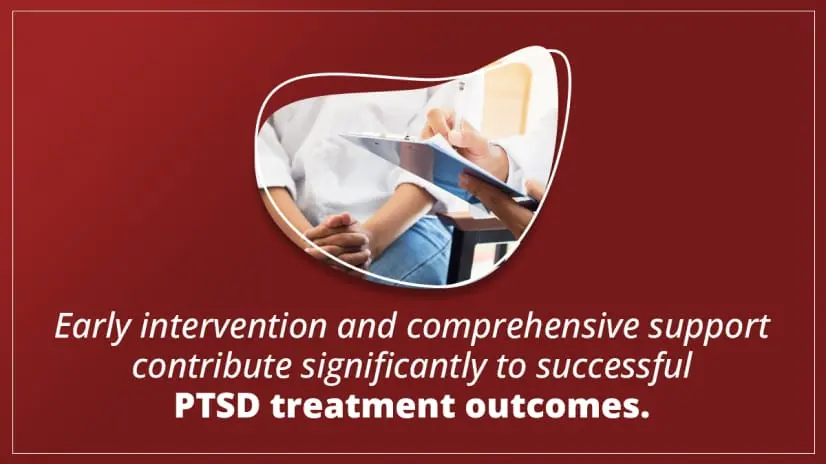
Harnessing the Power of Nature for Mental Health
Learn about the link between nature and mental health. Improve your mental health with Indiana Center for Recovery.

Post-Traumatic Stress Disorder (PTSD) is a debilitating mental health condition that can result from exposure to a traumatic event. Its impact extends beyond the initial experience, affecting individuals’ daily lives and well-being.
Fortunately, many effective treatments exist to ease the symptoms and enhance the quality of life for those affected. From evidence-based psychotherapies to pharmacological interventions, these treatments aim to address the core issues underlying PTSD.
Let’s explore the diverse approaches available to help individuals navigate the challenging path toward healing and recovery.

People with PTSD may go to great lengths to avoid reminders of the traumatic event. Here’s what you need to know:
Contact Indiana Center for Recovery at (844) 650-0064 for more information and personalized recovery assistance for long-term healing.
PTSD, or post-traumatic stress disorder, is a mental health condition that can develop after a person experiences a traumatic event. This could be something like a car accident, natural disaster, or exposure to violence.
People with PTSD often re-experience the traumatic event through intrusive memories or nightmares, which can cause intense emotional distress.
PTSD can significantly impact a person’s daily life, making it challenging to function normally. Those with PTSD may struggle with sleep disturbances, finding it hard to get a good night’s rest due to recurring nightmares or insomnia.
In addition, they might avoid places or events that remind them of the traumatic event, leading to social isolation. The condition can also contribute to difficulties in concentration and irritability, making it tough to focus on daily tasks and maintain healthy relationships.
Traditional PTSD treatments encompass various therapeutic approaches aimed at alleviating symptoms and promoting healing. These methods are rooted in evidence-based practices and have shown effectiveness in addressing the challenges associated with PTSD.
Cognitive therapy is an extensively used and effective treatment for PTSD. It emphasizes identifying and changing negative thought patterns and behaviors related to traumatic experiences. Therapists guide people to develop healthier coping mechanisms, aiding them regain control over their emotions and reactions.
Eye Movement Desensitization and Reprocessing (EMDR) is a specialized therapy designed to reduce the emotional impact of traumatic memories. During sessions, individuals recall distressing memories while the therapist facilitates bilateral stimulation, often through eye movements.
This process aids in desensitization and reprocessing traumatic memories, diminishing their emotional intensity over time.
Prolonged Exposure Therapy involves gradually facing and confronting trauma narrative in a safe environment. Therapists assist individuals in confronting avoided situations, memories, and emotions related to the trauma. Repeated exposure teaches patients to tolerate distress and reduce fear responses, promoting healing and desensitization.
Stress Inoculation Training is a therapeutic approach that equips individuals with stress management skills. Patients learn to identify and challenge negative thoughts, manage anxiety, and cope with stressors effectively. SIT helps individuals build resilience and develop tools to navigate the challenges associated with PTSD.
Group therapy provides a supportive environment where individuals with PTSD can share their experiences and learn from others facing similar struggles. Led by a trained therapist, group sessions foster a sense of community, reducing isolation.
Participants gain insights, coping strategies, and encouragement from their peers, promoting a collective healing process.
PTSD can be challenging to manage, but medications can be a crucial part of treatment. Different types of medications are used to address various symptoms associated with PTSD, including:
Antidepressants are commonly prescribed to individuals with PTSD to alleviate symptoms such as anxiety and depression. Selective serotonin reuptake inhibitors (SSRIs) like sertraline and paroxetine are frequently used.
These medications work by increasing the levels of serotonin in the brain, aiding in stabilizing mood and reducing feelings of sadness or worry.
Mood stabilizers like lamotrigine and divalproex sodium are employed in PTSD treatment to regulate emotional highs and lows. These medications assist in stabilizing mood swings, reducing irritability, and preventing intense emotional fluctuations that often accompany PTSD.
Antipsychotic medications, such as risperidone and olanzapine, may be prescribed in cases where individuals with PTSD experience symptoms associated with psychosis, like hallucinations or severe paranoia.
These medications help to manage distorted thoughts and perceptions, promoting a clearer and more stable mental state.
Beta-blockers, like propranolol, are sometimes used to address the physiological symptoms of PTSD, such as increased heart rate and trembling. These medications work by blocking the effects of adrenaline, helping to reduce the “fight or flight” response.
This can be particularly beneficial in lessening the intensity of physical reactions to traumatic memories.
Post-traumatic stress disorder (PTSD) can be a challenging condition, but there are alternative treatment options beyond traditional methods. These alternatives aim to provide relief and support, catering to individuals with varying needs.
Trauma-sensitive yoga (TSY) is an innovative approach that integrates mindfulness and gentle yoga practices to address PTSD symptoms. TSY focuses on creating a safe environment, allowing individuals to reconnect with their bodies and manage stress.
The controlled movements and breath awareness contribute to emotional regulation, promoting healing.
Service animals play an important role in supporting individuals with PTSD. These specially trained animals provide companionship and emotional support, helping to reduce anxiety and create a sense of security.
The bond formed with a service animal can enhance overall well-being, offering comfort during challenging moments.
Neurofeedback therapy utilizes technology to monitor and regulate brain activity. In the context of PTSD, this therapy aims to train the brain to manage stress and improve emotional regulation. By providing real-time feedback on brainwave patterns, people can learn to self-regulate, diminishing the impact of PTSD symptoms.
Hypnosis is a therapeutic technique that involves guided relaxation and focused attention. In the context of PTSD, hypnosis aims to access the subconscious mind to address and reframe traumatic experiences.
While its effectiveness varies among individuals, some find relief from symptoms such as flashbacks and nightmares through this alternative approach.
Recent advancements in technology have brought about groundbreaking changes in the treatment of PTSD, offering hope and relief to those affected. These innovations focus on enhancing therapeutic approaches and tailoring interventions to individual needs.
Let’s have a look at them:
One notable breakthrough is Virtual Reality Exposure Therapy (VRET), a technique that immerses individuals in computer-generated environments replicating traumatic experiences. This method provides a controlled space for patients to confront and process their fears, gradually reducing anxiety and improving coping mechanisms.
VRET has proven effective in recreating real-life scenarios, making it a valuable tool in the arsenal against PTSD.
Another cutting-edge technology making waves in PTSD treatment is Transcranial Magnetic Stimulation (TMS). This non-invasive procedure involves applying magnetic fields to specific brain areas associated with emotional regulation.
TMS shows promise in alleviating symptoms by modulating neural activity, offering a potential alternative or adjunct to traditional therapies.
Biofeedback and neurofeedback technologies represent a personalized approach to PTSD treatment. These tools monitor physiological responses and brain activity, providing real-time feedback to individuals.
Patients learn to regulate their stress levels and emotional reactions, empowering them to participate actively in their healing journey. These user-friendly technologies offer a promising avenue for enhancing therapeutic outcomes in a more accessible and engaging manner.
The effectiveness of PTSD treatments is assessed through statistical analysis. Researchers use data to measure how well different interventions work. Studies compare the outcomes of individuals who receive treatment with those who don’t. Numbers reveal the extent of symptom reduction or improvement.
For example, a study might find that a specific therapy reduces PTSD symptoms by 30 percent. This means that individuals who underwent the therapy experienced a significant decrease in their symptoms compared to those who did not receive the treatment.
Statistical methods also help identify trends and patterns in large groups, providing insights into the overall effectiveness of certain approaches. By analyzing data, researchers can determine if a treatment consistently leads to positive outcomes.
These statistical insights are crucial for healthcare professionals and policymakers in making informed decisions about which PTSD treatments to prioritize and implement. They contribute to evidence-based practices, ensuring that individuals with PTSD receive the most effective and beneficial interventions.
In addressing PTSD, personalized treatment emerges as a pivotal factor in fostering recovery. Each individual’s trauma experience is unique, necessitating tailored therapeutic approaches. Customizing PTSD treatment accounts for diverse backgrounds, cultural nuances, and the varied nature of traumatic events.
By acknowledging these differences, mental health professionals can optimize interventions to align with individual needs, ensuring a more effective and empathetic healing process.
The most effective PTSD treatment, recognized by the American Psychological Association, involves trauma-focused talk therapies like cognitive processing therapy. Studies support cognitive therapy’s efficacy in addressing trauma-related memories, benefiting both adults and children.
Professional help, particularly from mental health professionals and doctors, is crucial for implementing personalized treatment plans, reducing anxiety disorders, and providing necessary support.
Parents and caregivers play a dynamic role in accessing information and supporting those affected by traumatic events.
Trauma-focused cognitive behavioral therapy (CBT), prolonged exposure therapy, and narrative exposure therapy are effective treatments for PTSD. These evidence-based approaches address intrusive thoughts and trauma, offering coping ways for kids and young people.
Collaborate with medical professionals and providers to create a personalized treatment plan, considering potential side effects and incorporating support groups, especially for those affected by domestic violence.
Selective Serotonin Reuptake Inhibitors (SSRIs), such as sertraline and paroxetine, are commonly prescribed and considered the most effective medicines for treating PTSD. They help alleviate symptoms by regulating serotonin levels in the brain.
However, individual responses vary for side effects, and medication should be part of a comprehensive treatment plan that may include therapy and support. Consult with a healthcare professional to determine the diagnosis of PTSD.
Take control of your mental health at Indiana Center for Recovery
Our dedicated team of experts provides unparalleled mental health services, guiding you toward lasting recovery. Our residential treatment program offers a supportive environment where you can triumph over mental health struggles.
Your healing journey begins here. Contact us at (844) 650-0064 today for a better tomorrow.